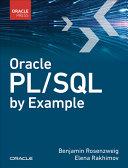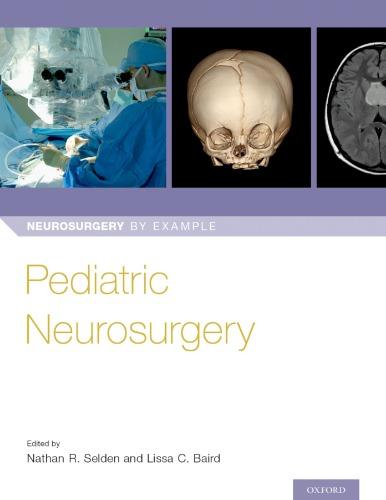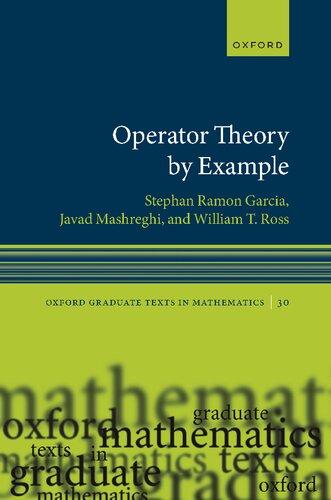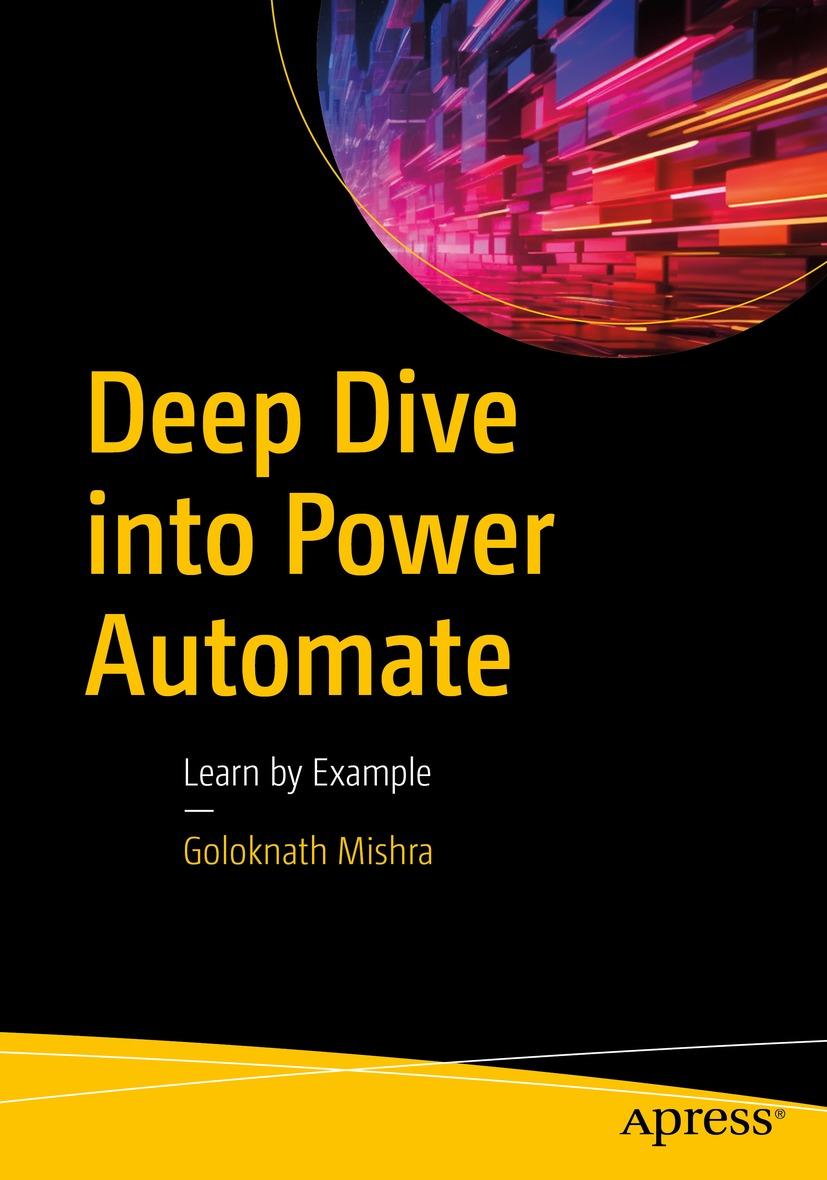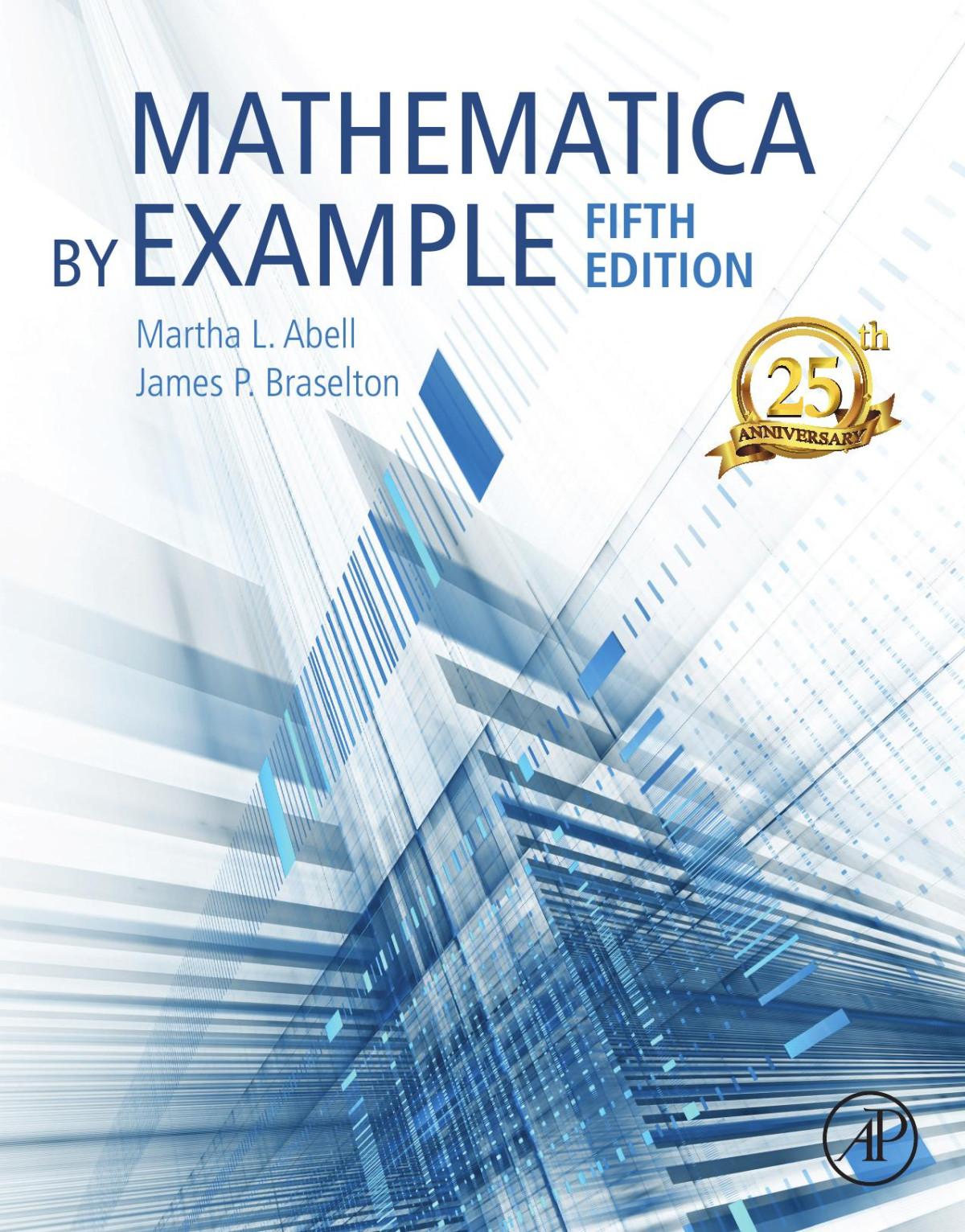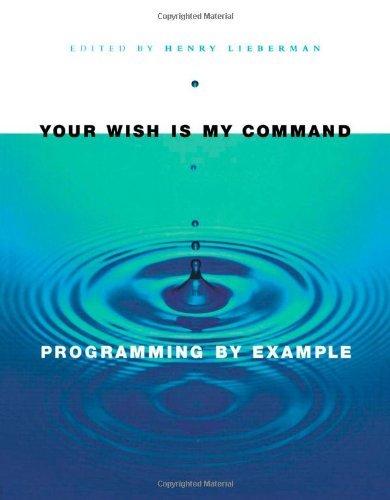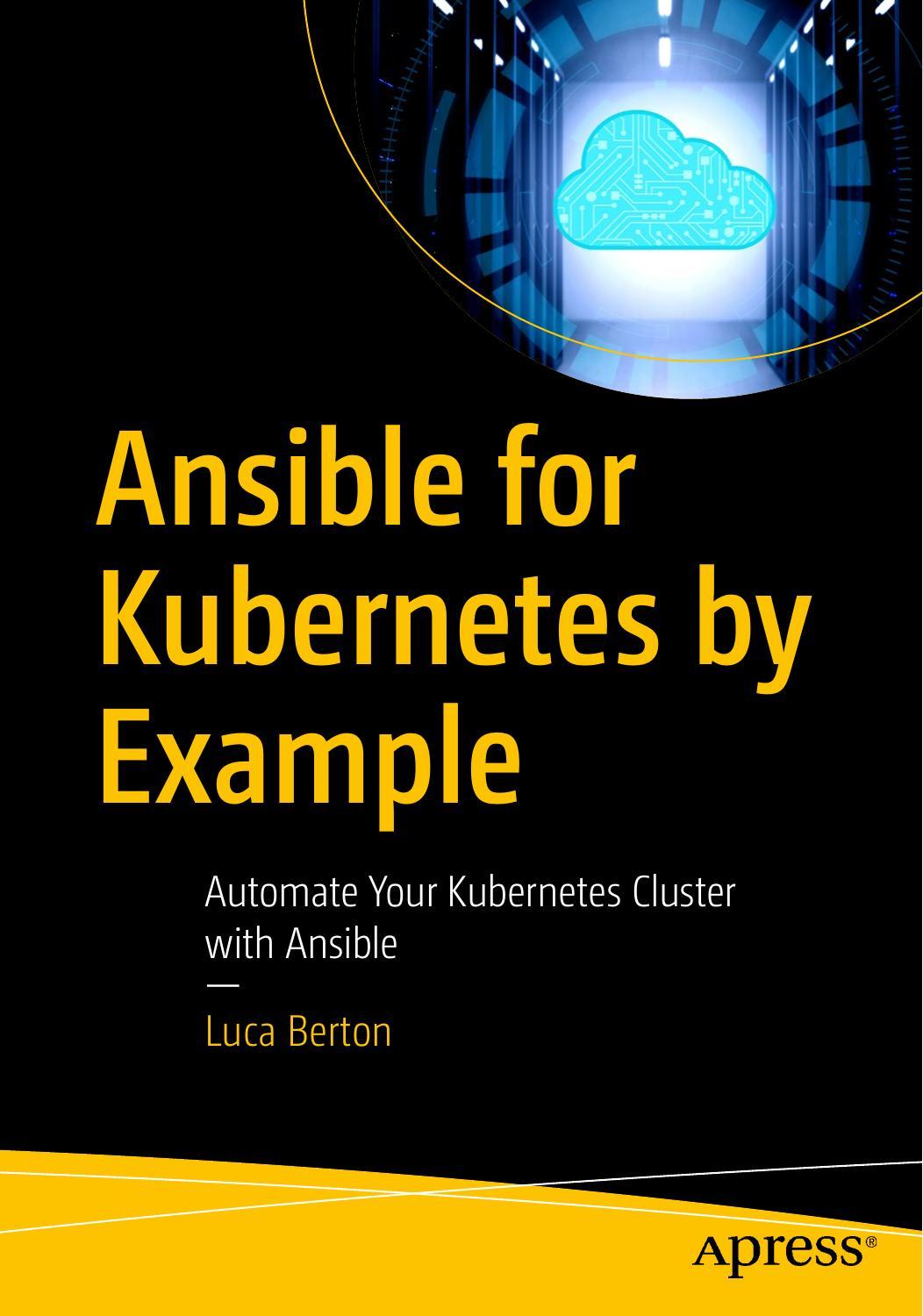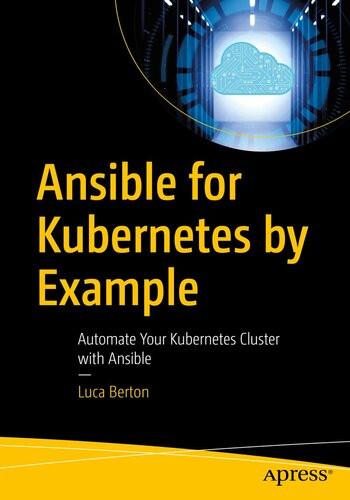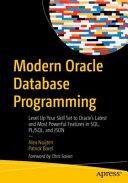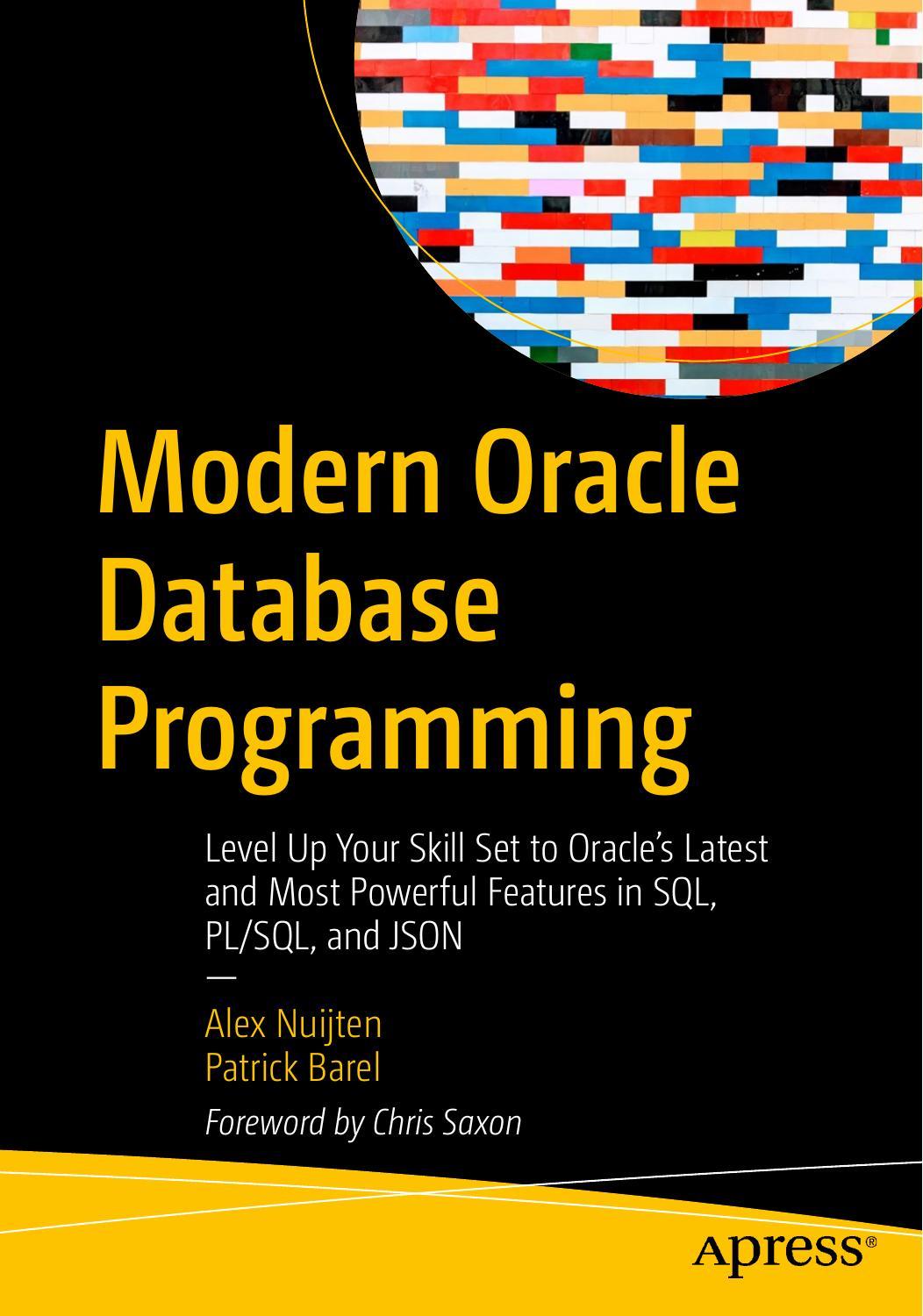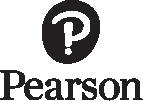Benjamin Rosenzweig
Visit to download the full and correct content document: https://ebookmass.com/product/oracle-pl-sql-by-example-6th-edition-benjamin-rosenz weig/
More products digital (pdf, epub, mobi) instant download maybe you interests ...
Pediatric Neurosurgery (Neurosurgery by Example) 1st
Edition Nathan Selden
https://ebookmass.com/product/pediatric-neurosurgeryneurosurgery-by-example-1st-edition-nathan-selden/
Operator Theory by Example 1st Edition Stephan Ramon Garcia
https://ebookmass.com/product/operator-theory-by-example-1stedition-stephan-ramon-garcia/
Deep Dive into Power Automate: Learn by Example 1st
Edition Mishra
https://ebookmass.com/product/deep-dive-into-power-automatelearn-by-example-1st-edition-mishra/
Mathematica by Example 5th Edition Martha L. Abell & James P. Braselton
https://ebookmass.com/product/mathematica-by-example-5th-editionmartha-l-abell-james-p-braselton/
Your Wish Is My Command: Programming by Example Henry Lieberman
https://ebookmass.com/product/your-wish-is-my-commandprogramming-by-example-henry-lieberman/
Ansible for Kubernetes by Example: Automate Your Kubernetes Cluster with Ansible 1st Edition Luca Berton
https://ebookmass.com/product/ansible-for-kubernetes-by-exampleautomate-your-kubernetes-cluster-with-ansible-1st-edition-lucaberton-2/
Ansible for Kubernetes by Example: Automate Your Kubernetes Cluster with Ansible 1st Edition Luca Berton
https://ebookmass.com/product/ansible-for-kubernetes-by-exampleautomate-your-kubernetes-cluster-with-ansible-1st-edition-lucaberton/
Modern Oracle Database Programming: Level Up Your Skill
Set to Oracle’s Latest and Most Powerful Features in SQL, PL/SQL, and JSON 1st Edition Alex Nuijten
https://ebookmass.com/product/modern-oracle-database-programminglevel-up-your-skill-set-to-oracles-latest-and-most-powerfulfeatures-in-sql-pl-sql-and-json-1st-edition-alex-nuijten-2/
Modern Oracle Database Programming: Level Up Your Skill
Set to Oracle’s Latest and Most Powerful Features in SQL, PL/SQL, and JSON 1st Edition Alex Nuijten
https://ebookmass.com/product/modern-oracle-database-programminglevel-up-your-skill-set-to-oracles-latest-and-most-powerfulfeatures-in-sql-pl-sql-and-json-1st-edition-alex-nuijten/
Contents at a Glance
Preface
Introduction to PL/SQL New Features in Oracle 21c
Chapter 1 PL/SQL Concepts
Chapter 2 PL/SQL Language Fundamentals
Chapter 3 SQL in PL/SQL
Chapter 4 Conditional Control: IF Statements
Chapter 5 Conditional Control: CASE Statements
Chapter 6 Iterative Control: Part I
Chapter 7 Iterative Control: Part II
Chapter 8 Error Handling and Built-in Exceptions
Chapter 9 Exceptions
Chapter 10 Exceptions: Advanced Concepts
Chapter 11 Introduction to Cursors
Chapter 12 Advanced Cursors
Chapter 13 Triggers
Chapter 14 Mutating Tables and Compound Triggers
Chapter 15 Collections
Chapter 16 Records
Chapter 17 Native Dynamic SQL
Chapter 18 Bulk SQL
Chapter 19 Procedures
Chapter 20 Functions
Chapter 21 Packages
Chapter 22 Stored Code Advanced Concepts
Chapter 23 Object Types in Oracle
Chapter 24 Storing Object Types in Tables
Chapter 25 Dynamic SQL with the DBMS_SQL Package
Appendix A PL/SQL Formatting Guide
Appendix B Student Database Schema
Index
Contents
Preface
Introduction to PL/SQL New Features in Oracle 21c
PL/SQL Extended Iterators
PL/SQL Qualified Expressions Enhancements
SQL Macros
New JSON Data Type
New Pragma SUPPRESSES_WARNING_6009
PL/SQL Type Attributes in Non-Persistable User-Defined Types
PL/SQL Function Enhanced Result Cache
Chapter 1 PL/SQL Concepts
Lab 1.1: PL/SQL Architecture
PL/SQL Architecture
PL/SQL Block Structure
How PL/SQL Gets Executed
Lab 1.2: PL/SQL Development Environment
Getting Started with SQL Developer
Getting Started with SQL*Plus
Executing PL/SQL Scripts
Lab 1.3: PL/SQL: The Basics
DBMS_OUTPUT.PUT_LINE Statement
Substitution Variable Feature
Summary
Chapter 2 PL/SQL Language Fundamentals
Lab 2.1: PL/SQL Language Components
PL/SQL Variables
PL/SQL Reserved Words
Delimiters
Literals in PL/SQL
Lab 2.2: Anchored Data Types
Lab 2.3: Scope of a Variable, Block, Nested Blocks, and Labels
Scope of a Variable
Nested Blocks and Labels
Summary
Chapter 3 SQL in PL/SQL
Lab 3.1: SQL Statements in PL/SQL
Initializing Variables with the SELECT INTO Statement
Using DML Statements in a PL/SQL Block
Using a Sequence in a PL/SQL Block
Lab 3.2: Transaction Control in PL/SQL
The COMMIT , ROLLBACK , and SAVEPOINT Statements
The SET TRANSACTION Statement
Summary
Chapter 4 Conditional Control: IF Statements
Lab 4.1: IF Statements
IF-THEN Statements
IF-THEN-ELSE Statements
Lab 4.2: ELSIF Statements
Lab 4.3: Nested IF Statements
Logical Operators
Summary
Chapter 5 Conditional Control: CASE Statements
Lab 5.1: CASE Statements
CASE Statements
Searched CASE Statements
Lab 5.2: CASE Expressions
Lab 5.3: NULLIF and COALESCE Functions
NULLIF Function
COALESCE Function
Summary
Chapter 6 Iterative Control: Part I
Lab 6.1: Simple Loops
EXIT Statement
EXIT WHEN Statement
Lab 6.2: WHILE Loops
Using WHILE Loops
Terminating the WHILE Loop Prematurely
Lab 6.3: Numeric FOR Loops
Using the IN Option in the Loop
Using the REVERSE Option in the Loop
Using Iteration Controls in the Loop
Terminating the Numeric FOR Loop Prematurely
Summary
Chapter 7 Iterative Control: Part II
Lab 7.1: CONTINUE Statement
Using the CONTINUE Statement
Using the CONTINUE WHEN Statement
Lab 7.2: Nested Loops
Using Nested Loops
Using Loop Labels
Summary
Chapter 8 Error Handling and Built-in Exceptions
Lab 8.1: Handling Errors
Lab 8.2: Built-in Exceptions
Summary
Chapter 9 Exceptions
Lab 9.1: Exception Scope
Lab 9.2: User-Defined Exceptions
Lab 9.3: Exception Propagation
Re-raising Exceptions
Summary
Chapter 10 Exceptions: Advanced Concepts
Lab 10.1: RAISE_APPLICATION_ERROR
Lab 10.2: EXCEPTION_INIT Pragma
Lab 10.3: SQLCODE and SQLERRM
Summary
Chapter 11 Introduction to Cursors
Lab 11.1: Types of Cursors
Implicit Cursor
Explicit Cursor
Lab 11.2: Table-Based and Cursor-Based Records
Table-Based Records
Cursor-Based Records
Lab 11.3: Cursor FOR Loops
Lab 11.4: Nested Cursors
Summary
Chapter 12 Advanced Cursors
Lab 12.1: Parameterized Cursors
Lab 12.2: Cursor Variables and Expressions
Cursor Variables
Cursor Expressions
Lab 12.3: FOR UPDATE Cursors
Summary
Chapter 13 Triggers
Lab 13.1: What Triggers Are
Database Trigger BEFORE Triggers AFTER Triggers
Autonomous Transaction
Lab 13.2: Types of Triggers
Row and Statement Triggers
INSTEAD OF Triggers
Summary
Chapter 14 Mutating Tables and Compound Triggers
Lab 14.1: Mutating Tables
Lab 14.2: Compound Triggers
Summary
Chapter 15 Collections
Lab 15.1: PL/SQL Tables
Associative Arrays
Nested Tables
Collection Methods
Lab 15.2: Varrays
Lab 15.3: Multidimensional Collections
Lab 15.4: Collection Iteration Controls and Qualified
Expressions
Collection Iteration Controls
Qualified Expressions
Summary
Chapter 16 Records
Lab 16.1: User-Defined Records
User-Defined Records
Qualified Expressions with Records
Record Compatibility
Lab 16.2: Nested Records
Lab 16.3: Collections of Records
Summary
Chapter 17 Native Dynamic SQL
Lab 17.1: EXECUTE IMMEDIATE Statements
EXECUTE IMMEDIATE Statement
Lab 17.2: OPEN FOR , FETCH , and CLOSE Statements
Summary
Chapter 18 Bulk SQL
Lab 18.1: FORALL Statements
FORALL Statements
SAVE EXCEPTIONS Option
INDICES OF Option
VALUES OF Option
Lab 18.2: The BULK COLLECT Clause
Lab 18.3: Binding Collections in SQL Statements
Binding Collections with EXECUTE IMMEDIATE
Statements
Binding Collections with OPEN FOR , FETCH , and CLOSE
Statements
Summary
Chapter 19 Procedures
Lab 19.1: Creating Nested Procedures
Nested Procedures
Parameter Modes
Forward Declaration
Lab 19.2: Creating Stand-Alone Procedures
Summary
Chapter 20 Functions
Lab 20.1: Creating Nested Functions
Lab 20.2: Creating Stand-Alone Functions
Summary
Chapter 21 Packages
Lab 21.1: Creating Packages
Creating a Package Specification
Creating a Package Body
Lab 21.2: Package Instantiation and Initialization
Package Instantiation and Initialization
Package State
Lab 21.3: SERIALLY_REUSABLE Packages
Summary
Chapter 22 Stored Code Advanced Concepts
Lab 22.1: Subprogram Overloading
Lab 22.2: Result-Cached Functions
Lab 22.3: Invoking PL/SQL Functions from SQL Statements
Invoking Functions in SQL Statements
Using Pipelined Table Functions
Using SQL Macros
Summary
Chapter 23 Object Types in Oracle
Lab 23.1: Object Types
Creating Object Types
Using Object Types with Collections
Lab 23.2: Object Type Methods
Using Constructor Methods
Using Member Methods
Using Static Methods
Comparing Objects
Summary
Chapter 24 Storing Object Types in Tables
Lab 24.1: Storing Object Types in Relational Tables
Lab 24.2: Storing Object Types in Object Tables
Lab 24.3: Type Evolution
Summary
Chapter 25 Dynamic SQL with the DBMS_SQL Package
Lab 25.1: Generating Dynamic SQL with the DBMS_SQL
Package
Summary
Appendix A PL/SQL Formatting Guide
Case
Whitespace
Comments
Appendix B Student Database Schema
Table and Column Descriptions
Index
Preface
Oracle PL/SQL by Example, Sixth Edition, presents the Oracle PL/SQL programming language in a unique and highly effective format. It challenges you to learn Oracle PL/SQL by using it rather than by simply reading about it.
Just as a grammar workbook would teach you about nouns and verbs by first showing you examples and then asking you to write sentences, Oracle® PL/SQL by Example teaches you about loops, cursors, procedures, triggers, and so on by first showing you examples and then asking you to create these objects yourself.
Who This Book Is For
This book is intended for anyone who needs a quick but detailed introduction to programming with Oracle’s PL/SQL language. The ideal readers are those with some relational database experience, with some Oracle experience, specifically with SQL, SQL*Plus, and SQL Developer, but with little or no experience with PL/SQL or with most other programming languages.
The content of this book is based primarily on the material that was taught in an Introduction to PL/SQL class at Columbia University’s Computer Technology and Applications (CTA) program in New York City. The student body was rather diverse, in that there were some
students who had years of experience with information technology (IT) and programming, but no experience with Oracle PL/SQL, and then there were those with absolutely no experience in IT or programming. The content of the book, like the class, is balanced to meet the needs of both extremes.
How This Book Is Organized
The intent of this workbook is to teach you about Oracle PL/SQL by explaining a programming concept or a particular PL/SQL feature and then illustrate it further by means of examples. Oftentimes, as the topic is discussed more in depth, these examples would be changed to illustrate newly covered material. In addition, most of the chapters of this book have “Additional Exercises” sections available through the companion website. These exercises allow you to test the depth of your understanding of the new material.
The basic structure of each chapter is as follows:
Objectives
Introduction
Lab
Lab…
Summary
The “Objectives” section lists topics covered in the chapter. Basically, a single objective corresponds to a single lab.
The “Introduction” offers a short overview of the concepts and features covered in the chapter.
Each lab covers a single objective listed in the Objectives section of the chapter. In some instances, the objective is divided even further into the smaller individual topics in the lab. Then each topic is explained and illustrated with the help of examples and corresponding outputs. Note that as much as possible, each example is provided in its entirety so that a complete code sample is readily available. These examples are also available through the companion website.
At the end of each chapter, you will find a “Summary” section, which provides a brief conclusion of the material discussed in the chapter.
About the Companion Website
The companion website is located at www.informit.com/title/9780138062835. Here you will find these very important things:
Files required to create and install the STUDENT schema.
Files that contain example scripts used in the book chapters.
“Additional Exercises” chapters where you are asked to create scripts based on the requirement provided. These exercises are meant to help you test the depth of your understanding.
By the Way
You need to visit the companion website, download the STUDENT schema, and install it in your database prior to using this book if you would like the ability to execute the scripts provided in the chapters and on the site.
What You Will Need
There are software programs as well as knowledge requirements necessary to complete the labs in this book. Note that some features covered throughout the book are applicable to Oracle 21c only. However, you will be able to run a great majority of the examples by using the following products:
Oracle 18c or higher
SQL Developer or SQL*Plus 18c or higher
Access to the Internet
You can use either Oracle Personal Edition or Oracle Enterprise Edition to execute the examples in this book. If you use Oracle Enterprise Edition, it can be running on a remote server or locally on your own machine. It is recommended that you use Oracle 21c or Oracle 18c to perform all or most of the examples in this book. When a feature will work in the latest version of Oracle database only, the book will state so explicitly. Additionally, you should have access to and be familiar with SQL Developer or SQL*Plus.
You have several options for how to edit and run scripts in SQL Developer or SQL*Plus. There are also many third-party programs to edit and debug PL/SQL code. Both SQL Developer and SQL*Plus are used throughout this book because they are two Oracle-provided tools and come as part of the Oracle installation.
By the Way
Chapter 1 has a lab titled “PL/SQL Development Environment” that describes how to get started with SQL Developer and SQL*Plus. However, most of the examples used in the book were executed in SQL Developer.
